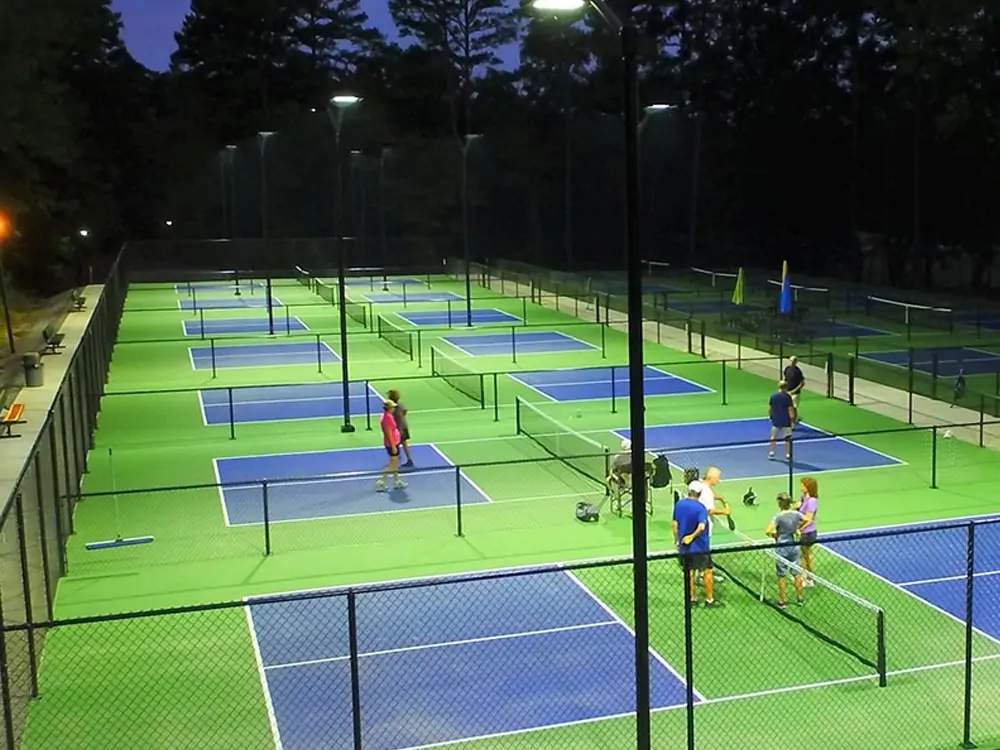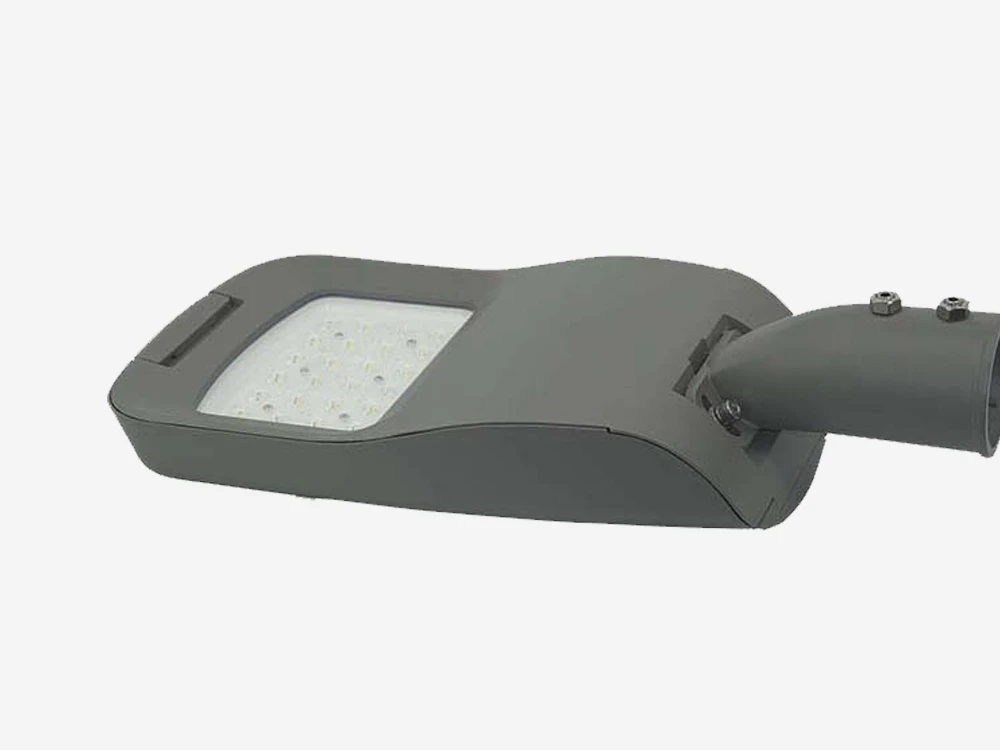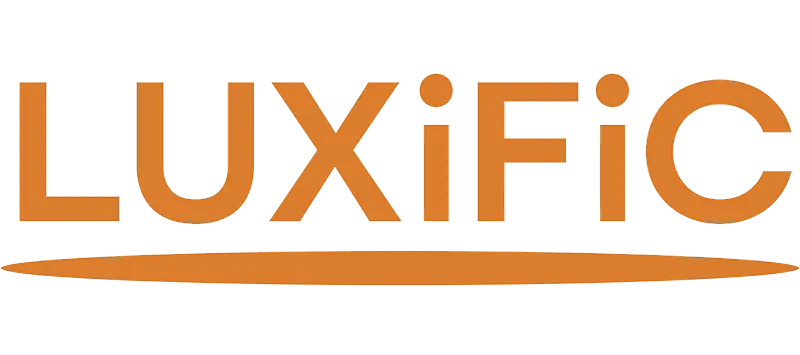全世界的人们都喜欢在白天打网球,因为网球比赛节奏快。同样,夜间练习和积极比赛时也需要照明条件。网球场照明对球员在日落后继续打球至关重要。本文将介绍网球场照明的许多不同方面。
What Are Tennis Court Lights?
Energy-efficient LED tennis lights offer dazzling, uniform illumination while conserving electricity. This makes it a prudent selection for indoor and outdoor courts.
LED technology has surpassed older illumination by offering superior light quality and durability. These uniform LED tennis lights illuminate the court in a tennis-specific way. It enables visibility of the ball and player movements.
LED lights also reduce energy consumption, leading to cost savings. Their bright, clear illumination can enhance player performance.
Why Do We Need Tennis Court Lights?

Outdoor Tennis Court Lighting
Most outdoor tennis courts have lighting fixtures affixed to poles outside the court. In modern outdoor panel designs, solar panels can charge external batteries for nighttime lights. These offer 3.5 hours of electricity-free illumination and can be affixed to a tall mast pole or a rooftop. This is also a viable alternative in the event of power disruptions.
Indoor Tennis Court Lighting
Light fixtures are suspended or mounted to ceiling brackets or suspension supports to illuminate an interior space. Additionally, they can be mounted to the upper perimeter of a wall rather than above. Lightning can provide any illumination level, whether a tennis court is intended for sporting events or recreational use.
Commercial
Commercial tennis courts are ubiquitous in schools, tennis clubs, and outdoor recreation facilities. Many enhance their courts’ aesthetic appeal by retrofitting or renovating their illumination. The illumination is more intense because these lights are designed for performances. They are also utilized in tournaments and semi-professionals. It has more refined color temperature and CRI levels.
Residential
A significant number of residences featuring backyard courts install nighttime illumination. LED floodlights for tennis can help extend evening matches, allowing players to enjoy the game for longer. LED lights are also energy-efficient, reducing electrical consumption and lowering energy bills. This makes them a cost-effective and environment-friendly choice for residential tennis courts.
Different Classes of Tennis Court Lighting
The Cobra head street light options serve as the best choice for saving on electrical energy. This is among the most attractive aspects of this incredible lighting option. This lighting option gives its users across the commercial and residential sectors the reliability they seek.
一级
This illumination is designated only for high-level competitions, such as those sanctioned by the US Open, USTA, and ITF. Strict requirements apply to CRI, GR levels, and Lux ratings for this form of illumination. It uses a limited color temperature spectrum. Even the intensity of foot candles is designated for nighttime tennis court illumination. This lighting class is designed to meet the rigorous standards of professional tennis. This ensures optimal visibility for players and spectators.
Class II
These are exclusive to challengers and college students recognized as semi-professionals in their leagues. When the number of foot candles is considered, this illumination has lower lover values despite remaining bright. The CRI, GR, and Lux ratings remain utilized as training tools at the Class Il Level.
Class III
This ultimate level is implemented in private and high school organizations. However, it still deserves high-quality tennis illumination. The color temperature differs, whereas the CRI, GR, and Lux ratings are all on the verge of being classified as semi-professional. The primary distinction is that these lights are pale white, as opposed to the natural hue of daylight.
Class IV
The rest is designated for public tennis courts, recreation centers, and municipal facilities. These feature a variety of illumination conditions that fall in optimal quality. However, it remains suitable for gameplay. Many private courts are unwilling to invest more funds in professional LED sports lighting.
Tennis Court Lighting Layout
You must ensure that a tennis court is adequate and uniformly illuminated. Designing the lighting layout using LED lights entails determining the optimal number of poles and power of each light.

8 Poles
By adorning eight poles, each measuring 6 meters (approximately 20 feet) in height. With 8 (400-watt MECREE LED lights, all illumination is increased to 783 lux.
This design provides an optimal level of illumination for courts measuring standard dimensions (36 by 18 meters or 120 by 60 feet). It caters to the requirements of broadcasting and competitive play.
6 Poles
One possible approach to customizing a 6-pole design is positioning each pole 29 feet (8.7 meters).
Installing six 300-watt MECREE LED lights increases the average luminosity to 500 lux. However, 200-watt lights reduce it to 300 lux.
Balancing between recreational and competitive environments permits customization of the court’s requirements.
4 Poles
A 4-pole configuration features poles extending to 12 meters (40 feet) in height. These poles provide a versatile illumination solution.
Four 500-watt MECREE LED lamps achieve an average luminance of 419 lux, which can be increased to 489 lux by substituting eight 300-watt lamps. This configuration lights the court for most game varieties despite having fewer poles.
How to Choose the Best Lighting for Your Tennis Court Lights?
Regarding the LED tennis court lights system, the below points should be considered for a better experience.
Placement of Poles
These pillars must be arranged along the court’s perimeter for consistent light distribution. The court’s dimensions and design must be considered to determine the quantity and pole position.
Also, the direction and height at which the lights are positioned are critical factors. This helps mitigate reflections and shadows and ensures uniform and efficient court illumination.
Eight poles could be utilized to illuminate a standard 36-by-18-meter tennis court. For instance, with each pole positioned at the perimeter’s extremities and midpoint.
Anti-Glare Lens
Visibility is impaired, and glare can be distracting. It makes it difficult for participants to concentrate on the game. To combat this, selecting illumination systems incorporating anti-glare technology is crucial.
Incorporating specialized anti-glare lenses into tennis court-led lighting mitigates the light intensity. It ensures that participants can perceive details with clarity and comfort. This characteristic is beneficial in competitive environments where precise vision is critical.
Color Temperature
Choosing a lighting system that emits a mild white light, between 5000 and 6000 Kelvin, is its optimal purpose. By reflecting natural daylight, this color temperature improves visibility. It facilitates athletes’ precise distance judgments and ball perception.
For instance, installing LED lamps that emanate light at 5500K enhances the playing experience. They simulate the sensation of playing outdoors on a clear day.
Waterproofing
This functional attribute protects the lamps from precipitation and moisture. It also ensures their uninterrupted operation regardless of the weather. Selecting LED lighting with a high waterproof classification is a prudent decision.
For example, LED lights with an IP65 rating repel water ingress. It renders them appropriate for outdoor tennis court lights that encounter precipitation.
This degree of safety ensures maintaining the lights’ optimal performance and longevity. However, irrespective of the weather conditions safeguarding your lighting investment.
Luminous Efficacy

The primary consideration when selecting illumination for a tennis court is the level of luminosity. In tennis, where the ball is small and played at a rapid tempo, high light intensity is essential for players to check the ball.
Choose LED sports lights, known for their high-lumen output, to illuminate your court. These lights are capable of adjusting their luminosity. It also empower you to accommodate different playing conditions. These conditions are weather fluctuations or the time of day, ensuring an optimal playing experience.
By providing players with optimal visibility, LED lights can improve their focus and athletic prowess.
During fast-paced games, players can use LED sports lights to identify and follow the tennis ball. Its luminosity output of 50,000 lumens illuminate a standard tennis court.
结论
A tennis court requires adequate illumination to guarantee player comfort and safety. The efficacy and cost of a lighting system may be influenced by its design, installation, and upkeep. By selecting energy-efficient LED lights, you can reduce expenses and ensure safety.
